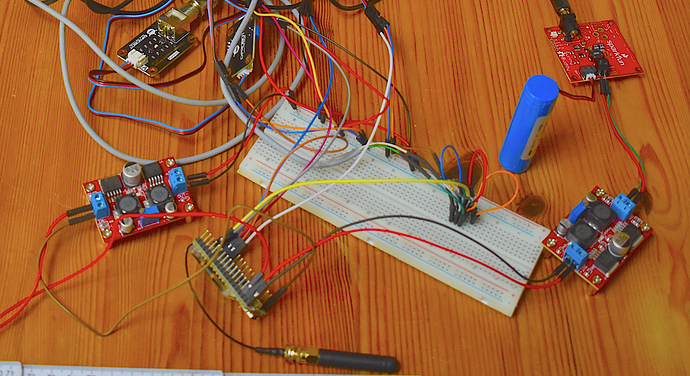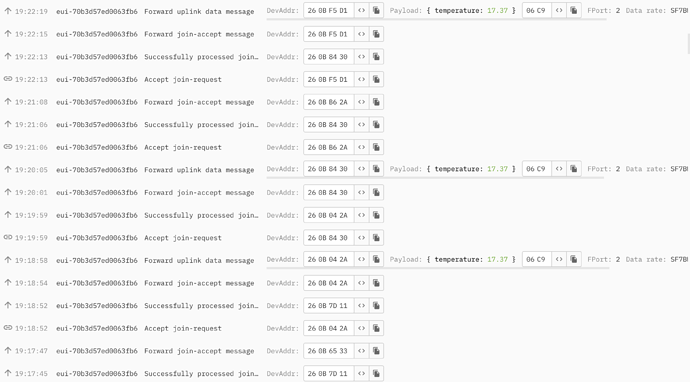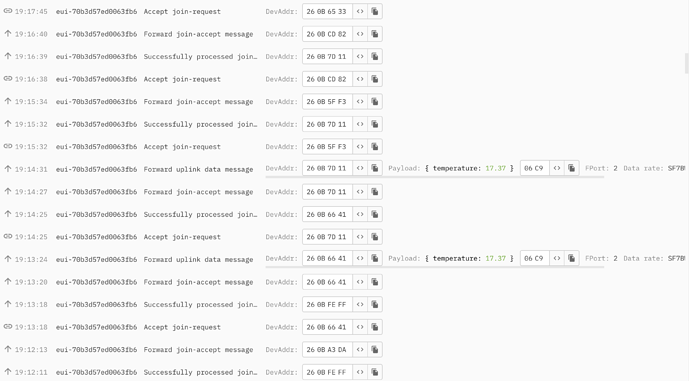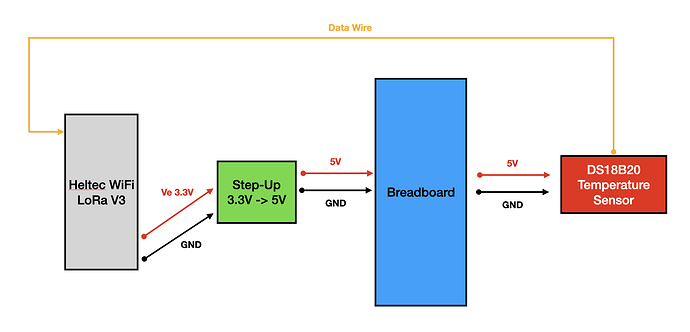Thank you very much!
Okay, so I uploaded the Heltec example LoRaWAN code to my board to reset it, then I uploaded workingCode.ino again to see what that does. Without attaching any sensors and just powering the board via USB, the code was executed properly with the board going into deep sleep. Next, while in deep sleep, I plugged all the sensors back on powering them with GND and 5V on the Heltec board. Unfortunately, just 5 minutes before the next data transmission (I had unfortunately kept the deep sleep time at 30 minutes instead of setting it lower for testing purposes, stupid me), the Polish construction crew tasked with setting up a fibre optic cable cut through our current connection cable.  You know, despite my dad telling them in both German and English (unfortunately they understood neither) that they cannot dig there and there being like a thick yellow band on top that says “careful! cable” …
You know, despite my dad telling them in both German and English (unfortunately they understood neither) that they cannot dig there and there being like a thick yellow band on top that says “careful! cable” …
Anyways, since my LoRa Gateway is connected to my home internet connection, I currently cannot test anything with it. Sure, I could try resetting that thing to my mobile hotspot but I fear that it will cause more issues than fixing them. The construction crew alerted their bosses to breaking our cable, so hopefully, someone will come tomorrow (it’s a Saturday so technically still a working day) and fix that for us, otherwise I’ll be quite mad because I wanted to get this running smoothly and collecting nice data as I’m presenting my work next week and it would have been nice to show some real-time values on my laptop. – sighs –
If you could test the code and tell me what it does for you, I’d appreciate that a lot. I hope supper was delicious.
@bns So I don’t have a lengthy log file but I will just add the snippet I got when the board was not entering deep sleep; that snippet repeated continuously so I think even with just a short log it might tell you a lot already.
15:09:53.974 -> joining...
15:09:59.144 -> joined
15:09:59.904 -> confirmed uplink sending ...
15:10:14.009 -> received unconfirmed downlink: rssi = -74, snr = 15, datarate = 5
15:10:16.052 -> Guru Meditation Error: Core 1 panic'ed (StoreProhibited). Exception was unhandled.
15:10:16.052 ->
15:10:16.052 -> Core 1 register dump:
15:10:16.052 -> PC : 0x400570e8 PS : 0x00060430 A0 : 0x82002cdc A1 : 0x3fce2ed0
15:10:16.154 -> A2 : 0x00000000 A3 : 0x00000000 A4 : 0x00000400 A5 : 0x00000000
15:10:16.154 -> A6 : 0x3fce3e84 A7 : 0x00000040 A8 : 0x60023000 A9 : 0x60023040
15:10:16.189 -> A10 : 0x15968d40 A11 : 0x000fffff A12 : 0x00000000 A13 : 0x00000001
15:10:16.189 -> A14 : 0x00060420 A15 : 0x00000001 SAR : 0x0000000a EXCCAUSE: 0x0000001d
15:10:16.189 -> EXCVADDR: 0x00000000 LBEG : 0x400570e8 LEND : 0x400570f3 LCOUNT : 0x0000003f
15:10:16.189 ->
15:10:16.189 ->
15:10:16.189 -> Backtrace:0x400570e5:0x3fce2ed0 |<-CORRUPTED
15:10:16.189 ->
15:10:16.189 ->
15:10:16.189 ->
15:10:16.189 ->
15:10:16.189 -> ELF file SHA256: 0000000000000000
15:10:16.189 ->
15:10:16.189 -> Rebooting...
15:10:16.189 -> ESP-ROM:esp32s3-20210327
15:10:16.189 -> Build:Mar 27 2021
15:10:16.189 -> rst:0xc (RTC_SW_CPU_RST),boot:0x8 (SPI_FAST_FLASH_BOOT)
15:10:16.189 -> Saved PC:0x4202f3e6
15:10:16.189 -> SPIWP:0xee
15:10:16.189 -> mode:DIO, clock div:1
15:10:16.189 -> load:0x3fce3808,len:0x43c
15:10:16.189 -> load:0x403c9700,len:0xbec
15:10:16.189 -> load:0x403cc700,len:0x2a3c
15:10:16.189 -> SHA-256 comparison failed:
15:10:16.189 -> Calculated: dcde8d8a4817d9bf5d5d69a7247667264e4e10ac7493514868b61f5aa6146539
15:10:16.189 -> Expected: ffffffffffffffffffffffffffffffffffffffffffffffffffffffffffffffff
15:10:16.189 -> Attempting to boot anyway...
15:10:16.189 -> entry 0x403c98d8
15:10:16.380 -> Start
15:10:16.414 -> Setup fertig
15:10:16.643 ->
15:10:16.643 -> LoRaWAN EU868 Class A start!
15:10:16.643 ->
15:10:16.643 -> +OTAA=1
15:10:16.643 -> +Class=A
15:10:16.643 -> +ADR=1
15:10:16.643 -> +IsTxConfirmed=1
15:10:16.643 -> +AppPort=2
15:10:16.643 -> +DutyCycle=300000
15:10:16.643 -> +ConfirmedNbTrials=8
15:10:16.643 -> +ChMask=0000000000000000000000FF
15:10:16.643 -> +DevEui=[my-dev-eui-here](For OTAA Mode)
15:10:16.643 -> +AppEui=[my-app-eui-here](For OTAA Mode)
15:10:16.677 -> +AppKey=[my-app-key-here](For OTAA Mode)
15:10:16.677 -> +NwkSKey=00000000000000000000000000000000(For ABP Mode)
15:10:16.677 -> +AppSKey=00000000000000000000000000000000(For ABP Mode)
15:10:16.677 -> +DevAddr=00000000(For ABP Mode)
After that, the log repeats with joining.... What I never experienced before is all that stuff from Guru Meditation Error: Core 1 panic'ed (StoreProhibited). Exception was unhandled. to ELF file SHA256: 0000000000000000 and I think also that SHA-256 comparison failed: line; everything else I have seen when the board was booting or tried reconnecting.
Something strange is happening, I am just not exactly sure what is causing it. From the error message, it seems to be a fatal error, and for ESP specifically it’s apparently a CPU exception, so my guess is something in the code is/was screwing with the CPU storage. But that’s all I get from that, as I unfortunately not have much expertise with that. 
Once again, thank you for the help you are offering; it means a lot!

 ) and put the sensor in there, that got me 3.24V on the analog pin (max output of the sensor is 3.4V).
) and put the sensor in there, that got me 3.24V on the analog pin (max output of the sensor is 3.4V).
 You know, despite my dad telling them in both German and English (unfortunately they understood neither) that they cannot dig there and there being like a thick yellow band on top that says “careful! cable” …
You know, despite my dad telling them in both German and English (unfortunately they understood neither) that they cannot dig there and there being like a thick yellow band on top that says “careful! cable” …

 ) - you are a victim of the shoddy quality control that we call the electronics industry coupled with outlandish marketing that it’s all easy. I see this almost every day - happens to me, happens to clients, colleagues and forum users. So we get suckered in to taking what appears to be the shiny paved path to success but is in fact full of potholes & cul-de-sacs. For me on a current BLE project with a major vendor based in the Nordics (!), I’ve burnt through hundreds of hours and had to return to the BLE 101 materials countless times to reset my head.
) - you are a victim of the shoddy quality control that we call the electronics industry coupled with outlandish marketing that it’s all easy. I see this almost every day - happens to me, happens to clients, colleagues and forum users. So we get suckered in to taking what appears to be the shiny paved path to success but is in fact full of potholes & cul-de-sacs. For me on a current BLE project with a major vendor based in the Nordics (!), I’ve burnt through hundreds of hours and had to return to the BLE 101 materials countless times to reset my head.
 ).
). ).
).


